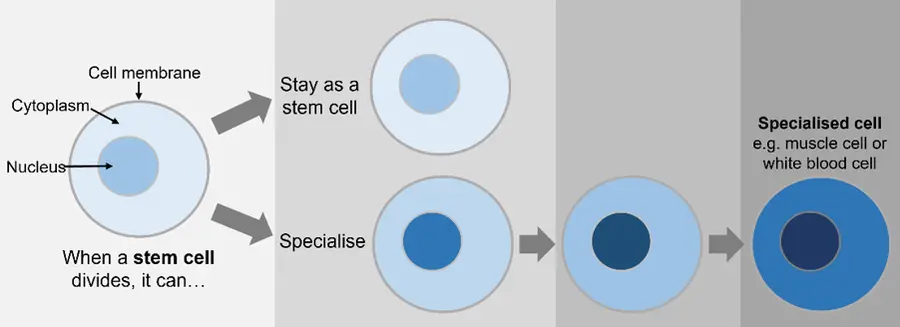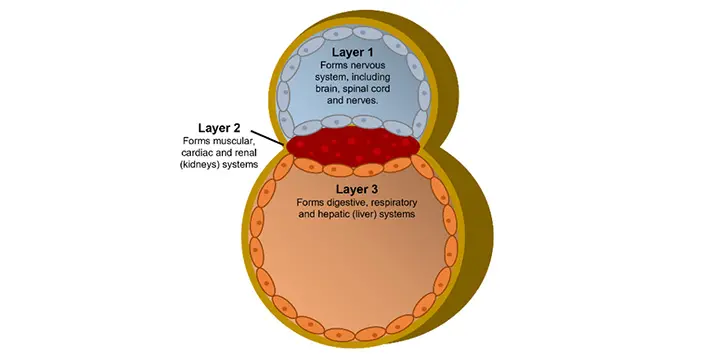Stem calls are a fascinating area of biology that has been heavily researched for its medical uses, especially in bone marrow transplantations to treat leukaemia and other blood-related disorders. However, work has also been looking into the use of stem cell therapies for neurodegenerative disorders and diabetes. But what are stem cells and why are they so useful?
A cell contains many essential components. In typical animal cells, three of these components are the cell membrane which encases the cell, the cytoplasm which makes up the body of the cell and where most of the chemical reactions take place and the nucleus which houses the DNA.
DNA is made up of regions which are organised into genes. Each gene codes for a molecule, called a protein, which has a particular function. Additionally, plant cells also have a rigid cell wall to provide more structure.
Stem cells are an unspecialised type of cell which act as a source of new cells in plants and animals.
When a stem cell divides, it can choose to become more specialised until it is a fully developed cell type. They do this by changing the arrangement of DNA in their nucleus. Genes can be switched on or off depending on how compact the DNA is.
Which specific genes are chosen to be switched on or off will determine the cell type that the stem cell will specialise into. You can learn more about how genes are switched on or off in this article

Types of stem cells
There are different types of stem cells with a range of functions and abilities.
Stem cells which are found in a human blastocyst (the collection of cells formed immediately after fertilisation) have the ability to become any cell in the foetus.
Adult stem cells in animals are typically more restricted. For example, blood stem cells can only become mature blood cells, such as red blood cells, white blood cells and platelets. Other adult stem cells are associated with the brain, muscles, bone and other tissues.
Plants also have stem cells, known as meristems. These are found primarily at the tips of shoots and roots, allowing for plant growth.
Embryonic stem cells
Embryonic stem cells are found in very early human embryos, five days after fertilisation. They can rapidly divide and form three layers of slightly more specialised cells in the developing embryo. Cells from the three layers can then specialise into over 220 different cell types to make up all the cells in the human body.
Embryonic stem cells are often used in scientific research as they are a useful model for understanding development. Scientists can grow embryonic stem cells on a Petri dish and change their genetics to depict different genetic disorders. This work has improved our understanding, alongside diagnostic and treatment possibilities, of cystic fibrosis and chromosomal disorders. Of course, the use of embryonic stem cells in scientific research comes with many ethical debates and issues. It is important to note that using these cells to model genetic disorders is separate from work on human cloning projects.

Adult stem cells
Adult stem cells refer to all stem cells found in humans postnatally, and they are essential for growth, repair and replenishment. Muscle stem cells will develop into more muscle cells during extended periods of exercise. Bone stem cells have an important role in repairing broken bones, and skin stem cells constantly replenish dead skin cells.
Blood stem cells produce billions of specialised blood cells every day, ranging from oxygen-carrying red blood cells, to immune-defensive white blood cells and scab-forming platelets. When you’re bleeding, platelets will be alerted to travel to and clot the damaged area. During this, signals are sent to the blood stem cells to divide and produce more platelets in response.
Blood stem cells are in the bone marrow and once they have divided and matured, the specialised blood cells are released into the bloodstream.
Stem cell therapies
Stem cell therapies are when these cells are taken from the bone marrow of a healthy donor and transplanted into a recipient. This is a common treatment strategy for blood diseases and disorders, including leukaemia.
Leukaemia can be caused by a mutation in blood stem cells which can lead to uncontrolled growth and development of specialised blood cells. However, it is possible that transplanting healthy blood stem cells into the bone marrow of someone with leukaemia will promote healthy and controlled growth of blood cells from the newly-received stem cells.
Stem cell research is a popular topic in biology. It will improve our understanding of how stem cells work, what happens when they go wrong, and how we can use them in new treatment possibilities for many diseases and disorders in the future.
About the author
Phoebe Crawley is a PhD student at the University of Dundee, Scotland. Her research focuses on the epigenetics of blood stem cells to improve understanding of leukaemia development. She is currently doing an internship at the Royal Institution in the Young Scientist Centre, where she is developing her science communication skills.
